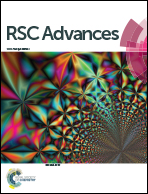Fabrication of C3N4 ultrathin flakes by mechanical grind method with enhanced photocatalysis and photoelectrochemical performance†
Abstract
In this paper, we prepared a large-sized multilayer C3N4 ultrathin flake photocatalyst with an approximately 90% yield rate by a facile wet mechanical grinding method. The blue shift phenomenon of the UV-Vis diffuse reflectance spectrum and photoluminescence spectrum indicated that a quantum effect was formed with the thickness of g-C3N4 (g-CN) when decreased to ultrathin flakes. The photocatalysis water reduction for hydrogen evolution performance of ultrathin flake C3N4 (UF-CN) was approximate 3.2 times higher than that of g-CN. In addition, the photoelectrochemical (PEC) property of UF-CN was increased more dramatically than that of g-CN. There are two possible reasons for photocatalysis and PEC performances of UF-CN promotion. First, the valence band (VB) potential of UF-CN was 1.59 eV, which was 0.25 eV more positive than that of g-CN, thus the oxidation capacity of UF-CN photogenerated holes would be stronger than the bulk counterpart. Secondly, the electrons transfer capacity on the horizontal plane of UF-CN was increased with the layered structure of the g-CN exfoliated to an ultrathin structure, thus prolonging the life time of the photogenerated electrons.


 Please wait while we load your content...
Please wait while we load your content...